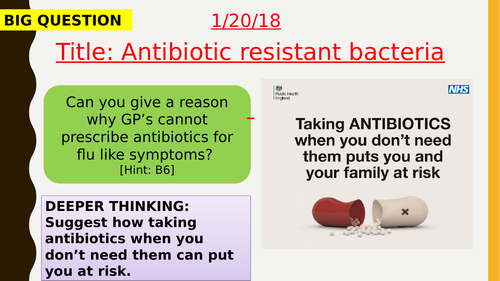

Antibiotic resistant bacteria lesson created in accordance to the NEW AQA Specification (9-1). Designed for higher ability class, although content can be adjusted to suit any ability. Includes: embedded videos and timers, slide animations, practice questions with answers on slides, worksheet and an interactive quiz. NB: If you are unable to play videos a URL link can be found in the slide notes.
AQA spec link: 4.6.3.7
Relevant chapter: B14 Genetics and evolution. AQA combined trilogy edition textbook-Page 196-197
Students are required to know the following;
Bacteria can evolve rapidly because they reproduce at a fast rate.
Mutations of bacterial pathogens produce new strains. Some strains might be resistant to antibiotics, and so are not killed. They survive and reproduce, so the population of the resistant strain rises. The resistant strain will then spread because people are not immune to it and there is
no effective treatment.
MRSA is resistant to antibiotics.
To reduce the rate of development of antibiotic resistant strains:
• doctors should not prescribe antibiotics inappropriately, such as
treating non-serious or viral infections
• patients should complete their course of antibiotics so all bacteria are
killed and none survive to mutate and form resistant strains
•the agricultural use of antibiotics should be restricted.
The development of new antibiotics is costly and slow. It is unlikely to keep up with the emergence of new resistant strains.
AQA spec link: 4.6.3.7
Relevant chapter: B14 Genetics and evolution. AQA combined trilogy edition textbook-Page 196-197
Students are required to know the following;
Bacteria can evolve rapidly because they reproduce at a fast rate.
Mutations of bacterial pathogens produce new strains. Some strains might be resistant to antibiotics, and so are not killed. They survive and reproduce, so the population of the resistant strain rises. The resistant strain will then spread because people are not immune to it and there is
no effective treatment.
MRSA is resistant to antibiotics.
To reduce the rate of development of antibiotic resistant strains:
• doctors should not prescribe antibiotics inappropriately, such as
treating non-serious or viral infections
• patients should complete their course of antibiotics so all bacteria are
killed and none survive to mutate and form resistant strains
•the agricultural use of antibiotics should be restricted.
The development of new antibiotics is costly and slow. It is unlikely to keep up with the emergence of new resistant strains.
Something went wrong, please try again later.
This resource hasn't been reviewed yet
To ensure quality for our reviews, only customers who have purchased this resource can review it
Report this resourceto let us know if it violates our terms and conditions.
Our customer service team will review your report and will be in touch.
£4.00
